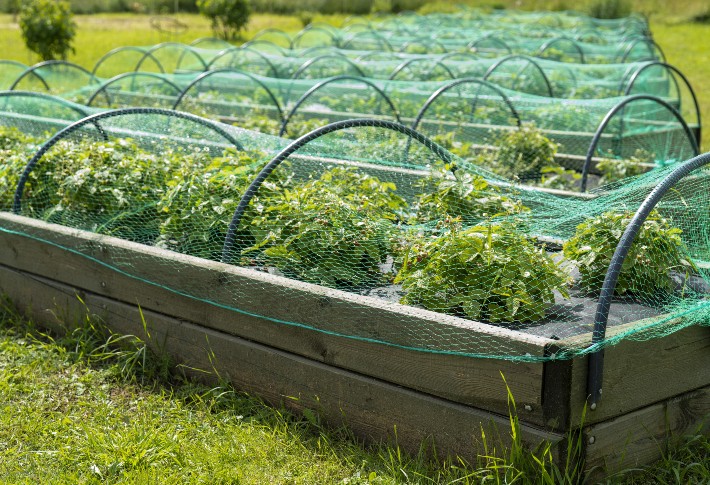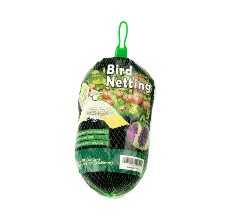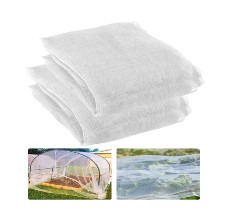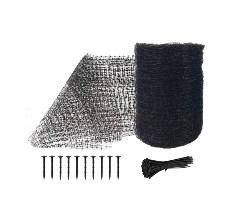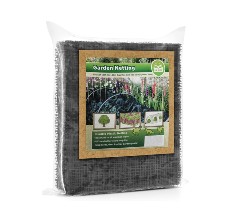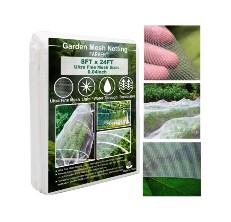- Flowers & PlantsVegetablesOur content is meticulously curated through independent research, testing, reviews, and AI-driven recommendations, all designed to present you with the finest product choices. When you make a purchase through our links, it could result in us earning a commission.
The Best Garden Netting of 2024
Last updated: Apr 16, 2024
Many of us know how easy it can be for bugs, birds, and animals to access gardens and destroy the plant life within. But did you know there is an easy and quick solution to protecting your greenery from these pests? Introducing garden netting, the go-to source for protecting your plants without the use of harmful chemicals or traps. This guide showcases some of the best garden netting that is durable, easy to install, and UV ray-resistant. Our number one pick, the invisible garden netting from PetiDream, not only provides effortless installation but is friendly on your wallet.
Our Top Picks For Garden Netting
- Best Overall: Petidream Garden Netting Shop Now ➔
- Runner Up: Alphatool Garden Netting Shop Now ➔
- Honorable Mention: Feitore Garden Netting Shop Now ➔
- Contender: De-Bird Garden Netting Shop Now ➔
- Also Consider: Faraer Garden Netting Shop Now ➔
View all ContentsThe Best Garden Netting
Best Overall
The Petidream garden netting offers protection to your plants against invading birds. It sends a message to birds that have been preying on your garden that there is no more free food. The net is made of polyethylene and can be easily cut to your desired size.
Pros
- The garden netting is easy to install.
- The garden netting is budget-friendly.
Cons
- The netting does not straighten out easily.
Key Features
The netting’s diamond-shaped holes that measure 3/5 inch x 3/5leave enough space for air and sun rays to penetrate but not enough for birds to feed on your plants. Depending on the size of your garden, you may select one of two sizes. You can either get the 13ft x 33ft or the 14ft x 45ft.
Runner Up
This lightweight garden netting from Alphatool is your go-to net when insects and bugs start to disturb your garden. The netting comes in a pack of two nets, with each piece measuring 9.8ft x 6.5 ft for a total of 19.6 ft x 6.5 ft. Alternatively, there are other sizes for larger gardens.
Pros
- The netting does not weigh down the plants.
- The netting is easy to use.
Cons
- When cut, the netting frays.
Key Features
The netting has tiny mesh that keeps tiny insects away but with enough room for air and sun to reach the plants.
Honorable Mention
The Feitore garden netting will save the day when you face pest problems on multiple fronts. The Feitore garden netting keeps birds and animals like squirrels and deers at bay. The netting is made of polypropylene and measures 7 ft x 100 ft.
Pros
- The netting is durable.
- The netting does not tangle
- The netting is reusable.
Cons
- The garden netting is expensive.
Key Features
The netting comes with 50 pieces of cable ties and 10 pieces of nails for easy installation. The net has ¾ inch square meshes. Users can easily cut the net to size if it is too big without worrying about frayed ends.
Contender
The De-bird garden netting offers you a formidable net option when the need arises. For your heavy-duty garden netting needs, this net will rise to the occasion. You can drape it over your plants with frames or use it as a fence screen.
Pros
- It is resistant to UV rays.
- The netting is easy to install.
Cons
- The netting is not cheap
Key Features
The netting is made of polypropylene and has a 3.5-inch mesh. The net is lightweight, and users can easily cut it to their desired size—the net measures 7.5 ft x 65 ft right out of the bag.
Also Consider
This ultrafine garden mesh netting from Faraer is an all-weather netting that will weather various harsh weather conditions without a kink. The net’s 0.8mm x 1mm mesh means air and sunlight can easily reach the plants while simultaneously keeping birds and other pests out.
Pros
- The netting is reusable.
- The garden net is resistant to UV rays.
- It is easy to install.
Cons
- The net is not easy to cut to size.
Key Features
The netting is made of polyethylene and measures 8ft x 24 ft. The net’s lightweight means it will not weigh down the plant if you choose to use it without frames and hoops.
Garden Netting: A Buyer's Guide
Garden nettings are deterrents that gardeners use to keep their plants safe from pests. If you are a first-time gardener, you need to understand that you are not the only one eyeing your produce. There are others who do not participate in the cultivation but are willing to reap the harvest – pests. In our review of the best garden nettings, we introduced you to various quality nets for your garden. The array of quality on display in the review may have you wondering how to pick the best netting. This buying guide will help you through the selection process by showing you what to consider when buying a netting. The guide explains the different types of garden nettings available. It also contains a frequently asked questions section where questions about garden nets and gardening are answered.
What are the Types of Garden Nettings?
Garden nets are categorized based on the type of pests they keep out. Based on this classification, we have the following types of nets for gardens:
Insect netting
Insect nettings come with fine mesh holes that ensure the normal flow of air and sun rays around the plant. However, insects cannot make their way through the net. Insect nettings are of two types – fine mesh and ultra-fine mesh. You should consider the type of insect your plants are up against when selecting any of the two. The ultra-fine mesh keeps out insects like onion flies and carrot flies. Fine mesh, on the other hand, keeps out insects like Pieris rapae.
Similar to insect nettings are butterfly nettings that keep butterflies out, which in turn ensures that our plant bed remains free of their larvae. It is a preemptive measure to prevent larvae from damaging plants. The size of the mesh on butterfly netting is usually wider than the ones on insect netting.
Deer netting
Sometimes the pests disturbing our plants are not tiny flying and crawling insects; they are four-legged wild animals like deer. With deer, we are not trying to make the mesh small enough to prevent entry. Rather, we want to make it formidable enough to avoid breaching. Deer nettings are erected as perimeter fencing to keep deer out of the garden. It is important to make it high enough to stop deer from scaling it.
Rabbit netting
Rabbit nets are similar to deer nettings because they are also used to keep out four-legged pests. However, they are usually buried under the ground to ensure that rabbits do not burrow and gain access from below. The mesh on rabbit nettings is typically smaller than the mesh on deer nettings.
Bird nettings
When you are up against winged creatures that dwell in the sky, bird nettings will save the day.
Nettings used to keep birds out of gardens and orchards are one of the most common with gardeners. When left unchecked, birds, especially frugivores, will peck on your fruits. The size of the mesh on bird nettings depends on the birds preying on your produce.
What Are the Things To Consider Before Buying Garden Nettings?
To ensure you get the most suitable netting for your garden, you must consider certain factors. By considering these factors, you have all angles covered, and you have the assurance that your plants are safe from pests.
Material
After deciding on the type of netting you need, the next thing is to consider the type of material used to make the net. The material used affects the net’s performance and overall durability. Polypropylene and polyethylene are the two most common materials used to make insect nets. Though the two materials are similar, they have their differences. Polyethylene is the most flexible of the two. However, polypropylene is the more resistant of the two materials. An important thing to look out for when choosing either of these materials is their ability to withstand harsh weather conditions.
Galvanized steel and polypropylene are the two most common materials used to make deer nettings. If you are choosing a net made of galvanized steel, ensure that it is PVC-coated. PVC-coated steel lasts longer than uncoated ones.
Dimension
You should also ensure that you get the dimensions of the area you need to protect before buying a netting. You should measure the length and width of the area correctly to avoid leaving some parts of the garden unprotected. When buying a deer netting, you should check the net’s height to ensure that it will stand at least 2 meters high after installation.
Finally, you should ensure that the net is lightweight, especially if you cover the plants with the netting directly without using a frame. A heavy net will weigh down the plants and lead to loss.
Ease of installation
It is also good to ensure that you can easily install a net when making a purchase. It would help if you looked out for things like installation materials and instructions added to the package. You should also ensure that you can easily cut the net to your desired size if needed.
For more information on how to use garden netting, check out this video by Lovely Greens.
How Much Do Garden Nettings Cost?
The price of garden netting depends on a few factors. The material used and the net’s dimensions are two prominent factors that affect the price. Garden nettings cost between $7 and $50.
People Also Asked
Is garden netting safe for use around children and pets?
Yes, garden netting can generally be safe for use around children and pets if installed properly and if it's made of materials that are non-toxic and sturdy enough to withstand potential contact. However, it's crucial to supervise children and pets around garden netting to prevent accidents or entanglement. Additionally, choosing netting with smaller mesh sizes can help reduce the risk of entrapment for small pets.
How do I install garden netting?
To install garden netting for pest protection, first, determine the type of pests you want to repel. Then, measure and cut the netting to fit over your garden beds or individual plants, ensuring it's securely anchored to the ground or surrounding structures. Regularly inspect and maintain the netting to prevent any gaps or tears that pests could exploit.
How do I maintain and clean garden netting?
To maintain and clean garden netting, regularly remove debris such as leaves, twigs, and insects that may accumulate on its surface. Use a gentle brush or cloth to remove dirt and grime, and if necessary, wash the netting with mild soap and water. Allow it to air dry completely before reinstalling to prevent mold or mildew growth.
Article Contributors
Read More About Garden Gate Review Team HereThe Garden Gate Review Team is a group of writers, editors, and gardeners, dedicated towards writing trustworthy product reviews that'll help you choose the best products for a beautiful garden and backyard.
Garden Gate is reader-supported: When you buy through links on our site, we may earn an affiliate commission. Artificial Intelligence (large language models) may have been used in the research and creation of the content.
Please reach out to aimperiapt@gmail.com with any questions regarding product testing or specific articles.
